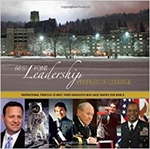NEWS Center
Leadership is deliberate. You don’t accidentally have successful teamsMonday, May 04, 2015
“Leadership is deliberate. You don’t accidentally have successful teams” says retired Lieutenant General Frank Kearney to a group of small business owners.
More than 130 dealers from a Fortune 50 automobile company have gathered at the United States Military Academy in West Point, N.Y., to attend the Thayer Leader Development Group’s leadership program. The three-day executive development program is designed to immerse business leaders in the habits and beliefs of the U.S. military. The day begins with a 7 a.m. boot camp of sit-ups, push-ups, and relays or a three-mile run on the West Point campus. Next comes a series of leadership exercises, workshops, and lectures like this one.
Kearney, who was formerly the Deputy Commander for USSOCOM, a 62,000-person global enterprise with a $10 billion budget, says business people tend to underestimate the similarities of leading an infantry and leading a company. The Army may not seek profits, but it certainly aims for results, he says, all while recruiting, training, and organizing thousands of people. “Disciplined processes create agile organizations,” he likes to say.
Here are a few lessons business leaders could learn from the U.S. military, according to the three-star general.
You’re only as strong as your least experienced team member.
It’s important that businesses establish trust in their organizations to gain credibility, says Kearney. “When we went to Afghanistan, it was important to work with people in the community. We talked to tribal leaders and showed them pictures of the twin towers falling and tried to explain why we were in their country or valley.” But that trust is easily eroded. It needs to be maintained from the lowest-level employee all the way to the top. Oftentimes, the receptionist communicates more about a business than its CEO, Kearney says, because they are the first line of contact for customers. And in the Army, it’s typically the young soldiers on the battlefield who represent the relationship. “Everyone in the organization is responsible for building and sustaining your brand.”
You have to know what right looks like for each role in the organization.
Management guru Jim Collins, author of “Good to Great,” says you need to get the right people on the bus, but Kearney says he tries to get the right person in the right seat. Ensuring that people truly fit in the role is one of the most difficult challenges leaders face, he says. The military uses physical training, aptitude and psychological testing, and skills assessments to assess, recruit, and place soldiers. Kearney says part of the skill in selecting people is “knowing what right looks like.” The profile of a Special Operations Force (SOF) operator, for example, is a leader between the ages of 29 and 34, with about eight years of experience in the general purpose force. They’ve attended multiple advanced tactical schools, have received cultural and language training, and gravitate toward “thinking sports” like track and problem-solving games like chess. Kearney recommends looking at who you have that is successful, figuring out why, and then trying to repeat it. The Navy, for instance, discovered that SEALs who are able to successfully complete the Basic Underwater Demolition School (BUDS) have three things in common: an inherent tolerance to cold water, swimming skills, and camaraderie with team members, he says. Business leaders, then, may consider looking for people who have the right temperament for their corporate environment, the skills to succeed in the role, and the personality to work effectively with the group.
You have to talk straight with your people.
You have a responsibility to everyone you bring into an organization, says Kearney, and that means having the courage to give candid feedback. He recalls a time earlier in his career when he was commanding a large unit in Italy. He had a young captain working for him who hoped to follow in the footsteps of his successful military father. Kearney had to decide whether to elevate him to a leadership role where he’d be in charge of 150 to 200 people. But ultimately, Kearney didn’t think he had the competence to succeed in that position. “I had to have a tough conversation,” he says. “I said, ‘I don’t think you can command an infantry company, but I think you have the skills to be successful in another discipline, and I’ll help you there.’ It was a crushing conversation for the young captain, but if he moved forward and failed, I would be responsible because I didn’t have the moral courage to be honest.” If you have the wrong person in a job, it’s better to admit it quickly and move them.
Shared challenges bond team members together.
“In the military, they sign up for patriotism, but they fight for each other,” says Kearney. One of the ways the military builds effective teams is by putting people in extremely challenging training situations together to give them a common shared experience. When Kearney was a new lieutenant, for instance, he attended an eight-week Ranger training course that included other future leaders like now-retired General Stanley McChrystal. He says they were hungry and sleep deprived the entire time. But sharing that experience bonded them and created a level of trust that later helped them succeed. Kearney and McChrystal went on to lead at the same time, and because they’d had that experience, he says communication and cooperation was easier because they trusted each other.
Effective communication is a three-part process.
Communication in the military happens in three steps: The leader gives orders, the subordinate reflects those orders back, and then the leader clarifies what may have been misunderstood. “We are in world where most communication is one way,” says Kearney. “Email is a classic example. We make assumptions that people understand our intentions, but just because you’ve sent an email doesn’t mean that people have read it, much less understood it. With three-way communication, you clear things up easier and faster.” This communication style, called a brief-back in the military, requires the leader to articulate and listen. Kearney says it’s a leader’s job to communicate the mission and also to make sure it’s understood and incorporated into the organization’s “battle rhythm.” If you listen at all levels of the business, you’ll know what’s being communicated, he says.
You must preserve your force and their families.
To do your best work, you have to have strength of mind, body, spirit, and family, says Kearney — that’s true for leaders and their teams. Physical fitness has long been a tenet of the military, which helps protect soldiers but also relieves stress and keeps energy levels high. Kearney says he’s exercised for two hours a day throughout his 35-year career, and he uses that time to think, prioritize, and center himself. “Every good leader I know has an energy level that I can’t comprehend. They bring it all the time,” he says. “How? They’re constantly working on it.” Moreover, Kearney says the importance of supporting employees’ family lives can’t be underestimated. “We have a responsibility to take care of their families, because if the family isn’t supportive, the employee is not going to stay with the company,” he says. “Whenever there’s something wrong in a family, the employee is distracted and isn’t going to perform well.”

West Point Leadership: Profiles of Courage
By Daniel Rice (USMA '88) & LTC John A. Vigna (USA, Ret.)
By Daniel Rice (USMA '88) & LTC John A. Vigna (USA, Ret.)
"Leadership is the fusion of heart and mind."
Brigadier General Rebecca Halstead,(USA, Retired, USMA 1981)
More +
More +





